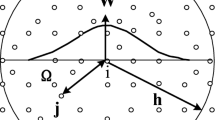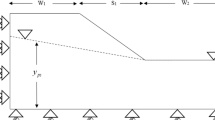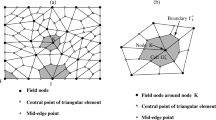Abstract
Slope instability failure is a large deformation problem. Traditional numerical methods and limit equilibrium methods are difficult to characterize the whole process of failure, resulting in unclear analysis of instability mechanism. A meshless method, smoothed particle hydrodynamics (SPH) method, is used to establish a numerical model of soil deformation and failure by adopting Drucker-Prager yield criteria to characterize the mechanical properties of soil. The validity of the model is verified by shear test, biaxial compression test and soil self-weight test. The damping coefficient and improved stress normalization algorithm are introduced to optimize the slope stress distribution and overcome the short-scale noise problem. Finally, the numerical simulation of the whole process of slope progressive instability failure is realized. On this basis, the tolerance is adopted. Based on the displacement mutation criterion, an improved SPH safety factor algorithm is adopted to calculate the slope safety factor and compared with the results of finite element software. The results show that SPH can effectively characterize the whole process of progressive failure of soil slope instability and overcome the shortcomings of non-convergence in the study of soil material deformation and failure by traditional numerical methods. At the same time, the improved SPH safety factor discrimination method overcomes the shortcomings of the fixed reduction coefficient algorithm and improves the calculation efficiency of the safety factor based on the meshless theory. The research results can provide a new method and idea for studying the disaster range and stability analysis of slope failure.



























Similar content being viewed by others
Data Availability Statement
The original contributions presented in the study are included in the article, and further inquiries can be directed to the corresponding authors.
References
Long X, Liu S, Ji S (2021) Breaking characteristics of ice cover and dynamic ice load on upward–downward conical structure based on DEM simulations. Comput Part Mech 8:297–313
Tran KM, Bui HH, Nguyen GD (2022) DEM modelling of unsaturated seepage flows through porous media. Comput Part Mech 9:135–152
González JM, Zárate F, Oñate E (2018) Pulse fracture simulation in shale rock reservoirs: DEM and FEM–DEM approaches. Comput Part Mech 5:355–373
Wu JH, Ohnishi Y, Nishiyama S (2004) Simulation of the mechanical behavior of inclined jointed rock masses during tunnel construction using discontinuous deformation analysis (DDA). Int J Rock Mech Min Sci 41:731–743
MacLaughlin MM, Doolin DM (2006) Review of validation of the discontinuous deformation analysis (DDA) method. Int J Numer Anal Meth Geomech 30:271–305
Chen X, Zhang L, Chen L et al (2019) Slope stability analysis based on the coupled Eulerian-Lagrangian finite element method. Bull Eng Geol Env 78:4451–4463
Donea J, Giuliani S, Halleux JP (1982) An arbitrary lagrangian-eulerian finite element method for transient dynamic fluid-structure interactions. Comput Methods Appl Mech Eng 33:689–723
Jiang M, Liu J, Shen Z (2018) Investigating the shear band of methane hydrate-bearing sediments by FEM with an elasto-plastic constitutive model. Bull Eng Geol Env 77:1015–1025
Wang J, Wei W, Zhang J et al (2020) Numerical investigation on the caving mechanism with different standard deviations of top coal block size in LTCC. Int J Min Sci Technol 30:583–591
He Y, Tang L, Sun R (2023) Discrete meta-analysis of slit dam intercepted particle flow based on PFC3D. Comput Part Mech 45:1–17. https://doi.org/10.1007/s40571-022-00542-1
Zhang B, He Q, Lin Z, Li Z (2021) Experimental study on the flow behaviour of water-sand mixtures in fractured rock specimens. Int J Min Sci Technol 31:377–385
Lucy LB (1977) A numerical approach to the testing of the fission hypothesis. Astrophys J 8:1013–1024
Monaghan JJ (1992) Smoothed particle hydrodynamics. Ann Rev Astron Astrophys 30:543–574
Bardenhagen SG, Brackbill JU, Sulsky D (2000) The material-point method for granular materials. Comput Methods Appl Mech Eng 187:529–541
Belytschko T, Lu YY, Gu L (1994) Element-free Galerkin methods. Int J Numer Meth Eng 37:229–256
Krysl P, Belytschko T (1996) Analysis of thin shells by the element-free Galerkin method. Int J Solids Struct 33:3057–3080
Oñate E, Idelsohn SR, Del Pin F, Aubry R (2004) The particle finite element method—an overview. Int J Comput Methods 1:267–307
Zhang DZ, Ma X, Giguere PT (2011) Material point method enhanced by modified gradient of shape function. J Comput Phys 230:6379–6398
Zhang X, Krabbenhoft K, Pedroso DM et al (2013) Particle finite element analysis of large deformation and granular flow problems. Comput Geotech 54:133–142
Duan Q, Belytschko T (2009) Gradient and dilatational stabilizations for stress-point integration in the element-free Galerkin method. Int J Numer Meth Eng 77:776–798
Colagrossi A, Landrini M (2003) Numerical simulation of interfacial flows by smoothed particle hydrodynamics. J Comput Phys 191:448–475
Gray JP, Monaghan JJ, Swift R (2001) SPH elastic dynamics. Comput Methods Appl Mech Eng 190:6641–6662
Leroch S, Varga M, Eder SJ et al (2016) Smooth particle hydrodynamics simulation of damage induced by a spherical indenter scratching a viscoplastic material. Int J Solids Struct 81:188–202
Zhao S, Bui HH, Lemiale V et al (2019) A generic approach to modelling flexible confined boundary conditions in SPH and its application. Int J Numer Anal Meth Geomech 43:1005–1031
Huang Y, Hao L, Xie P, Xu Q (2009) Numerical simulation of large deformation of soil flow based on SPH method. Chin J Geotechn Eng 31:1520–1524
Bui HH, Fukagawa R, Sako K, Ohno S (2010) Lagrangian meshfree particles method (SPH) for large deformation and failure flows of geomaterial using elastic-plastic soil constitutive model. Int J Numer Anal Meth Geomech 32:1537–1570
Bui HH, Sako K, Fukagawa R (2009) Slope stability analysis and slope failure simulation by SPH. In: Proceedings of the 17th international conference on soil mechanics and geotechnical engineering (Vol 1, 2, 3 and 4). IOS Press, pp 1578–1581
Nonoyama H, Moriguchi S, Sawada K, Yashima A (2015) Slope stability analysis using smoothed particle hydrodynamics (SPH) method. Soils Found 55:458–470
Nguyen CT, Nguyen CT, Bui HH et al (2017) A new SPH-based approach to simulation of granular flows using viscous damping and stress regularisation. Landslides 14:69–81
Man Hu, Fei Wu, Wang J, Zhang Y (2019) Simulation of influence range of slope instability based on smooth particle method. J Chongqing Univ 42:56–65 ((in Chinese))
Chen W, Qiu T (2014) Simulation of earthquake-induced slope deformation using SPH method. Int J Numer Anal Meth Geomech 38:297–330
Lu Z, Jin Z, Kotronis P (2022) Numerical analysis of slope collapse using SPH and the SIMSAND critical state model. J Rock Mech Geotechn Eng 14:169–179
Morris JP, Fox PJ, Yi Z (1997) Modeling low reynolds number incompressible flows using SPH. J Comput Phys 136:214–226
Randles PW, Libersky LD (1996) Smoothed Particle Hydrodynamics: some recent improvements and applications. Comput Methods Appl Mech Eng 139:375–408
Funding
The work was supported by the National Natural Science Foundation of China (Nos. 51934003), the Key Laboratory of Ministry of Education of China for Efficient Mining and Safety of Metal Mines (No. ustbmslab201906), the Yunnan Fundamental Research (NO. 202001AU070027), and Yunnan innovation team (NO. 202105AE160023).
Author information
Authors and Affiliations
Contributions
Song was responsible for the work concept or design, Song was responsible for drafting the manuscript, Wu was responsible for making important revisions to the manuscript, and Zhang and Wu were responsible for approving the final version of the manuscript for publication.
Corresponding author
Ethics declarations
Conflict of Interest
Authors Song, Zhang and Wu declare that the research was conducted in the absence of any commercial or financial relationships that could be construed as a potential conflict of interest.
Additional information
Publisher's Note
Springer Nature remains neutral with regard to jurisdictional claims in published maps and institutional affiliations.
Rights and permissions
Springer Nature or its licensor (e.g. a society or other partner) holds exclusive rights to this article under a publishing agreement with the author(s) or other rightsholder(s); author self-archiving of the accepted manuscript version of this article is solely governed by the terms of such publishing agreement and applicable law.
About this article
Cite this article
Song, X., Zhang, X. & Wu, S. Study on slope stability analysis and large deformation characteristics of failure based on SPH method. Comp. Part. Mech. 10, 1913–1929 (2023). https://doi.org/10.1007/s40571-023-00597-8
Received:
Revised:
Accepted:
Published:
Issue Date:
DOI: https://doi.org/10.1007/s40571-023-00597-8




